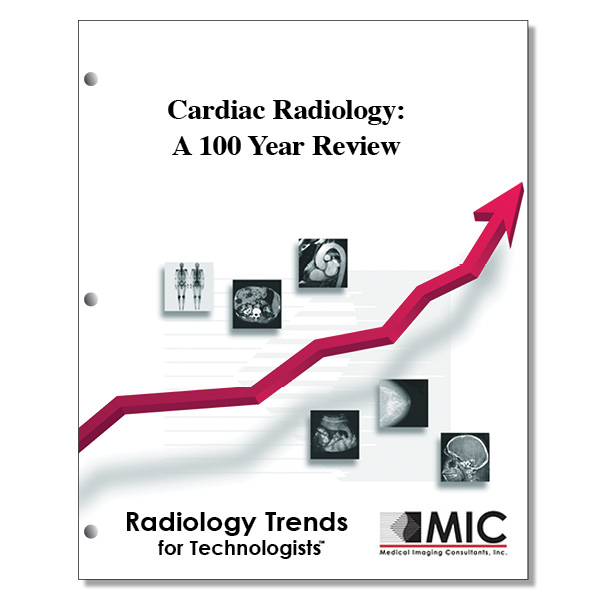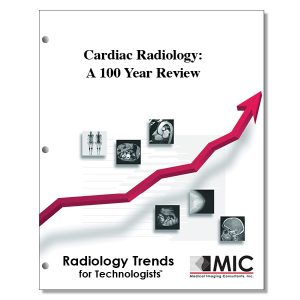

Cardiac Radiology: A 100 Year Review
A century of advancements in cardiac radiology are presented.
Course ID: Q00425 Category: Radiology Trends for Technologists Modalities: Cardiac Interventional, CT, MRI, Radiation Therapy, Radiography, Sonography3.5 |
Satisfaction Guarantee |
$37.00
- Targeted CE
- Outline
- Objectives
Targeted CE per ARRT’s Discipline, Category, and Subcategory classification for enrollments starting after May 9, 2023:
[Note: Discipline-specific Targeted CE credits may be less than the total Category A credits approved for this course.]
Cardiac-Interventional Radiography: 0.50
Procedures: 0.50
Diagnostic and Electrophysiology Procedures: 0.50
Computed Tomography: 0.50
Procedures: 0.50
Neck and Chest: 0.50
Nuclear Medicine Technology: 0.25
Procedures: 0.25
Cardiac Procedures: 0.25
Registered Radiologist Assistant: 0.50
Procedures: 0.50
Thoracic Section: 0.50
Outline
- Introduction
- early Stages of Cardiac Imaging (Pre-1950
- Radiography, Fluoroscopy, and Orthodiagraphy
- Roentgen Kymography
- Cardiac Angiography
- Coronary Arteriography
- Applications of Cardiac Angiography in Specific Acquired and Congenital Heart Disease
- Iodinated Contrast Media
- Cardiac US
- Nuclear Medicine Imaging
- Cardiac CT
- Coronary Calcifications
- Coronary CT Angiography
- Morphologic MR Imaging
- Congenital Heart Disease
- Ischemic Heart Disease
- Myocardial Perfusion Imaging
- Functional MR Imaging
- Coronary MR Angiography
Objectives
Upon completion of this course, students will:
- be familiar with imaging modalities being used at the beginning of the 20th century
- know which radiographic views were used to image the heart
- know what images were used for making heart measurements
- know which patient orientation was used for roentgen cinematography
- understand why roentgen cinematography provided only limited information about contraction of the myocardium
- know what anatomy was depicted by using barium to fill the esophagus
- be familiar with an early technique for recording heart motion
- know the route for contrast administration for early cardiac angiography
- be aware of a significant advancement in coronary arteriography
- know how coronary arteries differ from other arteries originating from the aorta
- know the risk factors for coronary artery disease as the cause of chest pain
- be aware of the potential cardiotoxicity of ionic iodinated contrast media
- know the definition of ionicity
- be familiar with iodinated contrast agents of choice
- list some advanced US imaging techniques
- recognize some nuclear medicine agents used for cardiac imaging
- be familiar with the nuclear medicine imaging techniques described
- be aware of some of the lesions cardiac CT demonstrated in the early 80s
- understand what needed to be optimized when CT acquisition time was shortened
- be able to compare prospectively and retrospectively gated CT techniques
- know the advantages of coronary CT angiography
- be familiaar with a drug used to slow heart rate for coronary CT angiography
- know pathology that was demonstrated by ECG gated morphologic MRI
- understand imaging techniques to demonstrate pericardial thickening
- know a condition specific to constrictive pericarditis
- be familiar with ways to help limit respiratory motion during MRI
- be aware of the potential for patient burns with ECG equipment in MRI
- understand MRI assessment of patients with repaired tetralogy of Fallot
- be familiar with modalities used to image congenital heart disease
- know the capabilities of four-dimensional MR flow imaging
- be familiar with MRI contrast media used for imaging ischemic heart disease
- know the purpose for nulling signal from normal myocardium
- be aware of technology used for molecular imaging with MRI
- be familiar with capabilities of delayed enhancement MR imaging
- know the advantages of parallel imaging in MRI
- know when the breath hold should begin for MR perfusion imaging
- understand why adenosine is given during MR stress perfusion
- understand the effect a steady-state free precession sequence has on the MR image
- know where to place the navigator for three-dimensional coronary MR angiography
- be familiar with the advantages of MR coronary angiography
